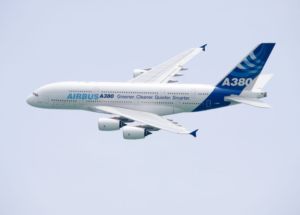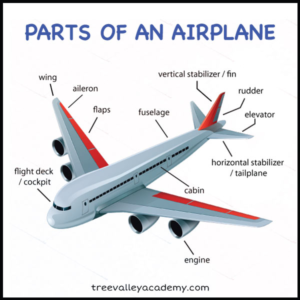Technical Description: Airplane

By Yulin Liu
Professor Maryam Alikhani
Writing for Engineering
The City College of New York
November 6, 2018
- Introduction
An airplane or aeroplane (informally plane) is a powered, fixed-wing aircraft that is propelled forward by thrust from a jet engine, propeller or rocket engine. Airplanes come in a variety of sizes, shapes, and wing configurations. The broad spectrum of uses for airplanes includes recreation, transportation of goods and people, military, and research. Worldwide, commercial aviation transports more than four billion passengers annually on airliners and transports more than 200 billion tonne–kilometres of cargo annually, which is less than 1% of the world’s cargo movement. Most airplanes are flown by a pilot on board the aircraft, but some are designed to be remotely or computer-controlled.
The Wright brothers invented and flew the first airplane in 1903, recognized as “the first sustained and controlled heavier-than-air powered flight”. They built on the works of George Cayley dating from 1799, when he set forth the concept of the modern airplane (and later built and flew models and successful passenger-carrying gliders). Between 1867 and 1896, the German pioneer of human aviation Otto Lilienthal also studied heavier-than-air flight. Following its limited use in World War I, aircraft technology continued to develop. Airplanes had a presence in all the major battles of World War II. The first jet aircraft was the German Heinkel He 178 in 1939. The first jet airliner, the de Havilland Comet, was introduced in 1952. The Boeing 707, the first widely successful commercial jet, was in commercial service for more than 50 years, from 1958 to at least 2013.
Airplanes are travelling machines that are manufactured to transport human beings and luggage from one location to another. Airplanes travel in air very faster compared to roadway vehicles, trains and ships.
III. Description of Parts
Airplanes are manufactured in manufactured in different shapes and sizes according to the need and desire. When Airplane is travelling it has to lift its own weight, the fuel, the passengers and the luggage.
For airplane, there are many parts to consist of it. They are wings, jet engine, cockpit, body, slats, spoiler, aileron, flaps, elevator, rudder, vertical stabilizer and horizontal stabilizer.
The fuselage or body of the airplane, holds all the pieces together. The pilots sit in the cockpit at the front of the fuselage. Passengers and cargo are carried in the rear of the fuselage. Some aircraft carry fuel in the fuselage; others carry the fuel in the wings.
Then, this following will describe many important parts.

Figure 1: All parts of an airplane (treevalleyacademy.com)
III.1 Wings
This is an important part because it works to help in balancing and improving the airplane’s stability when flying. This is the part that allows the plane to go up. There are two wings that are joined by a fuselage. The shape of the wings is designed that way in order to help it fly. If airplane doesn’t have wings, it will be imbalance and it cannot carry people to further destinations.
III.2 The engine
The engine is a major component that allows the aircraft to move. Every type of aircraft is created with a special type of engine that is made in accordance to its size. During the earlier years, aircraft owners used propeller-driven engines. These are traditional engines that are no longer being used. Planes that are developed today are using jet engines. With this, it is safe to say that even modern aircraft use engines for them to be able to work. There are different types of jet engines but the two types that are widely used are turbofan and turbojet. The engine needs to provide the power to turn the propeller to produce thrust for the flight. Propeller is a turning blade or twisted airfoil that produces thrust when powered by the engine.
III.3 The horizontal stabilizer
This part of the aircraft is also called the horizontal stabilizer. The main reason why this is included in the aircraft is to help in maintaining its stability when flying. The wing will not be able to do it alone without the help of this part. This is providing a counteracting force that helps when the aircraft faces disturbances while flying. At the rear of the fuselage of most aircraft one finds a horizontal stabilizer and an elevator. The stabilizer is a fixed wing section whose job is to provide stability for the aircraft, to keep it flying straight. The horizontal stabilizer prevents up-and-down, or pitching, motion of the aircraft nose.

Figure 2: The details and video of Horizontal Stabilizers (https://www.youtube.com/watch?v=tB69yThXWhk)
III.4 The fuselage
This fuselage is also called main body of airplane. This part is connected to the wings of the aircraft. This part actually comes in two different shapes; it may come in rectangular shapes or in cylindrical tubes. This serves as a connecting point for all the parts of the aircraft. This is where you will find the passengers and cargo. It holds crew, passengers, and cargo. In single-engine aircraft it will usually contain an engine, as well, although in some amphibious aircraft the single engine is mounted on a pylon attached to the fuselage, which in turn is used as a floating hull. The fuselage also serves to position control and stabilization surfaces in specific relationships to lifting surfaces, which is required for aircraft stability and maneuverability.
III.5 The rudder
This serves as a hinge that allows the plane to turn left. This helps in controlling the direction of the aircraft. On an aircraft, the rudder is a directional control surface along with the rudder-like elevator and ailerons (attached to the wings) that control pitch and roll. The rudder’s direction in aircraft since the “Golden Age” of flight between the two World Wars into the 21st century has been manipulated with the movement of a pair of counter-moving foot pedals by the pilot, while during the pre-1919 era rudder control was most often operated with by a center-pivoted, solid “rudder bar” which usually had pedal and/or stirrup-like hardware on its ends to allow the pilot’s feet to stay close to the ends of the bar’s rear surface.
III.6 Spoiler
The spoiler’s function is to disrupt, or spoil, the flow of air across the upper surface of the wings. They are usually found on larger aircraft, which can have two types installed. The in-flight spoilers are small and designed to reduce the lifting capability of the wing just enough to allow the aircraft to descend quicker without gaining airspeed. The ground spoilers are used to completely destroy the lifting ability of the wing upon landing, ensuring that the entire weight of the airplane rests firmly on the wheels, making the brakes more effective and shortening the length of runway needed to stop the aircraft.
III.7 History of airplane
In 1799, George Cayley set forth the concept of the modern airplane as a fixed-wing flying machine with separate systems for lift, propulsion, and control. Cayley was building and flying models of fixed-wing aircraft as early as 1803, and he built a successful passenger-carrying glider in 1853. In 1856, Frenchman Jean-Marie Le Bris made the first powered flight, by having his glider “L’Albatros artificiel” pulled by a horse on a beach. Then Alexander F. Mozhaisky also made some innovative designs. In 1883, the American John J. Montgomery made a controlled flight in a glider. In 1894, his machine was tested with overhead rails to prevent it from rising. The test showed that it had enough lift to take off. The craft was uncontrollable, which Maxim, it is presumed, realized, because he subsequently abandoned work on it. In the 1890s, Lawrence Hargrave conducted research on wing structures and developed a box kite that lifted the weight of a man. His box kite designs were widely adopted. Although he also developed a type of rotary aircraft engine, he did not create and fly a powered fixed-wing aircraft.
Between 1867 and 1896, the German pioneer of human aviation Otto Lilienthal developed heavier-than-air flight. He was the first person to make well-documented, repeated, successful gliding flights.
- Conclusion
In conclusion, airplane has played a very important role in our life and society. For travelling, any adventure activities, we cannot leave airplane. Airplane can bring people to vanish off the destinations we desired and expected. On the other hand, taking planes is the quickest means of travel. Also, airplane is made up of many minor parts—— wings, jet engine, cockpit, body, slats, spoiler, aileron, flaps, elevator, rudder, vertical stabilizer and horizontal stabilizer.
If airplane lacks of one part, it may not operate and unsafe. About airplane’s safety, when risk is measured by deaths per passenger kilometer, air travel is approximately 10 times safer than travel by bus or rail. However, when using the deaths per journey statistic, air travel is significantly more dangerous than car, rail, or bus travel. Air travel insurance is relatively expensive for this reason—insurers generally use the deaths per journey statistic. There is a significant difference between the safety of airliners and that of smaller private planes, with the per-mile statistic indicating that airliners are 8.3 times safer than smaller planes. The structural parts of a fixed-wing aircraft are called the airframe. The parts present can vary according to the aircraft’s type and purpose.
References
Airplane Parts and their Function by Vinodh Reddy Chennu, updated Feb 12, 2015, from https://me-mechanicalengineering.com/airplane-parts-function/
Functionality of Different Parts of Aircraft, copyright in 2013 from http://theatlasgroup.biz/functionality-different-parts-aircraft/
History and any contents of airplane, from https://en.wikipedia.org/wiki/Airplane#Safety
Parts of airplane by NASA, from https://www.hq.nasa.gov/office/aero/pdf/parts_of_an_airplane_9-12.pdf
Figure 1: All parts of an airplane, from treevalleyacademy.com
Figure 2: The details and video of Horizontal Stabilizers, from https://www.youtube.com/watch?v=tB69yThXWhk


